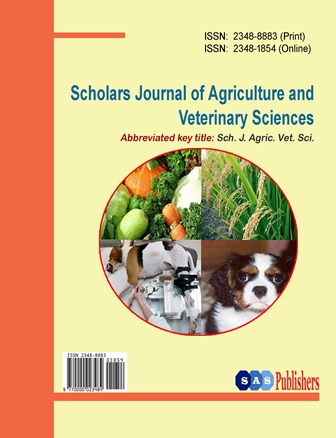+91-9365665504
+91-8724002629
submit@saspublishers.com / saspjournals@gmail.com

An International Publisher for Academic and Scientific Journals
Author Login
Scholars Journal of Agriculture and Veterinary Sciences
Journal Home
Description
Editorial Board
Archives
Indexing
Statistics
Title : Scholars Journal of Agriculture and Veterinary Sciences
Abbr : Sch J Agric Vet Sci
ISSN (Online) : 2348-1854
ISSN (Print) : 2348-8883
Discipline : Agriculture and Veterinary
Frequency : Monthly
Country : India
Language : English
Abbr : Sch J Agric Vet Sci
ISSN (Online) : 2348-1854
ISSN (Print) : 2348-8883
Discipline : Agriculture and Veterinary
Frequency : Monthly
Country : India
Language : English
10.36347/sjavs
DOI
DOI
4.7
IMPACT FACTOR
IMPACT FACTOR
Current Issue : Volume-12 - Issue-12 ; 2025
Recently Published Articles
Dec. 22, 2025 | Original Research Article
Evaluation of Selected Woodlot Tree Species in Dry Land of Yabello District, Borana Zone, Ethiopia
Sisay Taye, Siraj Kelil
Sch J Agric Vet Sci | 336-342
DOI : https://doi.org/10.36347/sjavs.2025.v12i12.002
Dec. 5, 2025 | Original Research Article
In vitro Evaluation of the Entomopathogenic Activity of Beauveria bassiana Against Cochliomyia hominivorax at Different Stages of Development
Trinidad Castillo-Arévalo, Bosco Castillo-Cruz
Sch J Agric Vet Sci | 330-335
DOI : https://doi.org/10.36347/sjavs.2025.v12i12.001
Nov. 27, 2025 | Original Research Article
Research and Practice on The Molecular Design and Free Radical Scavenging Mechanism of Polyphenolic Antioxidants
Hongjie Qu, Quan Sun, Panpan Du, Dongxue Ding, Xue Li, Jinling Gao
Sch J Agric Vet Sci | 323-329
DOI : https://doi.org/10.36347/sjavs.2025.v12i11.005





